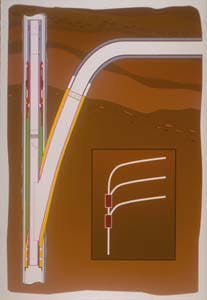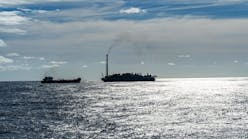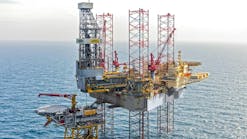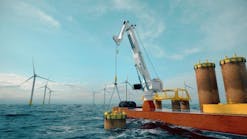Leonard LeBlanc
Houston
North Sea platform tank cleanup major cost for operators
There are 410 platforms in the North Sea. An estimated 35 of the structures, virtually all concrete gravity units, contain tankage of some kind. After the fields under them are no longer productive, most operators had originally planned to reballast the structures, tow them into shallow water, and break them up.
The option to sink the structures in deep water had not been considered until recently when estimated disposal costs began to exceed accruals. One of the situations pushing up disposal costs is tank contents, and disposal of the Brent Spar offloading tower has focused more light on it.
Tanks were an attractive feature favoring concrete gravity construction. The tanks were used to conveniently store crude, sediment, bitumens, and other bottom materials resulting from topside processing, as well as ballast water. Would that more of the tanks had been used only for ballast water.
Unless the tanks can be freed of hydrocarbon byproducts, offshore disposal cannot be considered. In the case of shallow water breakup, cleaning may be necessary before breakup can be considered. There is concern among operators that the cost of tank cleaning will be much larger, now that environmental authorities have become involved. Taking advantage of the option to sink the gravity bases in deep water could help recoup the high costs associated with cleanup.
The sinking of space frame jackets in the US Gulf of Mexico has met with growing acceptance among regulators, fishermen, and environmentalists, but none of the jackets contain tankage of enclosed hydrocarbon products. There is a question whether most European governments would accept the sinking of space frame jackets in the North Sea or Eastern Atlantic, let alone concrete gravity structures. Once the tanks have been cleaned, and disposal sites are selected below trawl depths, only the aesthetics of bottom disposal should present a problem for regulators or public officials.
Multilateral tie-back technology pace picking up with use
"Multilateral wells are currently in a similar stage of evolution within BP as ERD (extended reach drilling) and horizontal wells were in 1988..." explains David Roberts, the editor of BP in-house technical publication, Downhole Talk. Like extended reach drilling, multilateral completions provide for drainage through one surface well of more than one part of a reservoir or more than one reservoir.
Most offshore operators have situations that call for production access to more than one reservoir and the downhole conditions to produce all at one time. To meet this need,
Baker and Sperry-Sun already have multilateral tie-back systems in the field. Halliburton's new system is on contract for use by BP at Prudhoe Bay, Alaska and in the North Sea.
Halliburton says its system is the first to establish multiple drainage laterals with full liner connectivity with only one reduction in casing size from the parent. The company established a joint development team with BP, Arco, assisted by Weatherford, to provide a complete drilling and tie-back package.
A multilateral tie-back system being developed by Halliburton, BP, and Arco on Alaska's North Slope features a single casing size reduction connection to the parent.
Can grouting of jacket joints solve repair problems?
Can filling of steel platform jacket chords with grout improve strength and impact resistance, thereby reducing the need for repair or replacement? This is what a UK-US sponsored joint industry project wants to know. Rough weather in the North Sea has taken a toll on platform jacket members in the UK sector, requiring costly re-welding and replacement when jacket chords crack, distort, or oval. The US Gulf of Mexico has a long history of framing member replacement, particularly following hurricanes.
Testing of grouted and ungrouted T-joints and double T-joints is being conducted by MSL Engineering Ltd. (Tel: 44-1344-874424) in the UK. Researchers know that grout increases radial stiffness of the chord and restricts chord wall deformations, both of which reduce local stresses. But is the achievement worth the additional cost and design accommodation?
Northstar may be first test of Arctic offshore pipeline
British Petroleum has a dual challenge to the development of the Northstar discovery, located six miles offshore Alaska's Arctic shoreline: installing a pipeline in seas where multi-year ice gouges the seabed, and doing it at a very low cost.
Pipelines have been constructed before under permanent ice (Canadian Arctic Islands), but not under seabeds subject to winter ice gouging. Three Russian pipelines (two under western Siberia offshore - Pechorskoye More and Baydaratskaya Guba, and a third under the Sea of Okhotsk off northern Sakhalin Island) have been proposed for winter ice conditions, but none are near the engineering stage.
The Northstar discovery has reserves estimated at 100-200 million bbl and would require 40-50 wells to produce 50,000-75,000 b/d. A causeway out to the site would be prohibitively expensive and likely would not be permitted. A conventional pipeline would have to be buried deep under the seabed to escape ice gouging, present in the deeper water offshore Alaska.
Well control research tips on bullheading, diverter erosion
An industry review of research in well control methods produced some findings by Dr. William Koederitz and Alok Jain, as reported by John R. Smith in the August 1995 joint industry edition of The Brief:
- Bullheading: Dr. William Koederitz (M/D Totco) - (1) The maximum surface pressure during a bullhead killing operation (pumping mud down a gas-filled annulus) occurs at the time of fracture initiation. (2) All the gas in the annulus can be displaced downward if the annular velocity of fluid is high enough; under sub-level velocity conditions, some gas will remain in the annulus and rise to the surface when pumping is halted. Research is continuing on the needed velocity for various size annuli.
- Diverter erosion: Alok Jain - (1) When diverter flow is impinged at a 30 angle, the most erosion resistant material tested against A-36 steel was Stellite 6K, which provided twice the lifespan of steel. (2) When flow impingement was at a direct right angle, a gas metal arc-applied nickel steel (UNS N 06625) was the most successful.
Copyright 1995 Offshore. All Rights Reserved.






